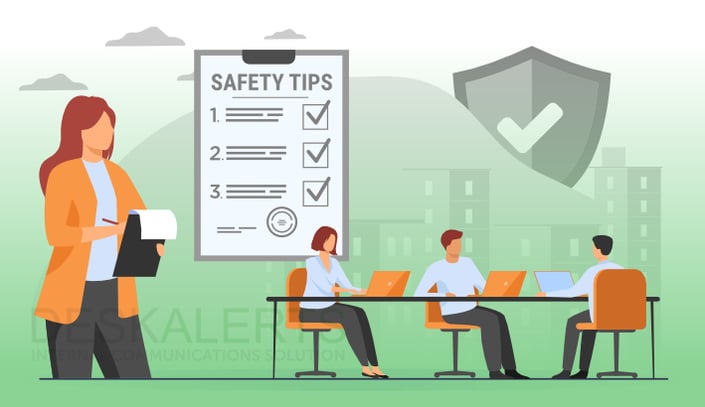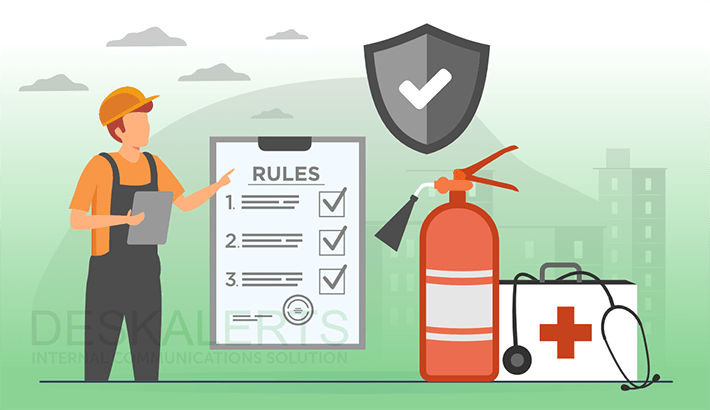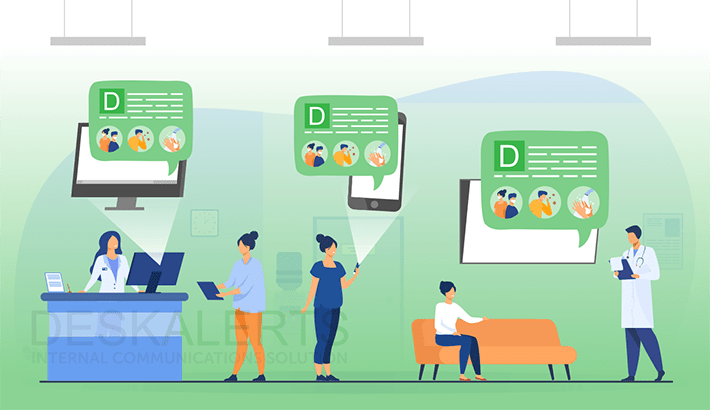
Workplace safety and health is important for every organization, no matter how big or small. Employers have legal and moral obligations to keep their employees safe. But workplace safety is everyone’s responsibility. Communicating safety tips at the workplace to employees can help ensure everyone is safe.
WHO’S IN CHARGE OF KEEPING THE WORKPLACE SAFE?
In any workplace, ensuring safety is a collective responsibility, but typically, there are designated individuals or departments tasked with overseeing safety protocols and regulations. The primary responsibility often falls on the employer or business owner to create a safe working environment. They are legally obligated to adhere to workplace safety standards and provide necessary resources for maintaining safety.
Most organizations usually designate a safety officer or a safety committee responsible for implementing safety measures, conducting risk assessments, and providing safety training to employees. In larger companies, there might be dedicated safety managers or coordinators who work closely with various departments to address safety concerns.
Government agencies, such as the Occupational Safety and Health Administration (OSHA) in the United States, also play a crucial role in setting and enforcing workplace safety standards. They conduct inspections, provide guidelines, and ensure compliance with regulations to promote workplace safety.
SUPPORTING SAFETY
Businesses can support workplace safety by implementing comprehensive safety policies and procedures. This includes conducting regular risk assessments, providing appropriate safety training to employees, and ensuring access to necessary safety equipment and resources.
Creating a culture of safety where employees feel empowered to report hazards and near-misses is essential. Regular safety audits and inspections can help identify and address potential safety issues promptly.
Fostering open communication channels between management and employees regarding safety concerns and actively involving employees in safety initiatives can significantly contribute to a safer work environment.
10 WORKPLACE SAFETY TIPS OF THE WEEK FOR EVERY EMPLOYEE
While there are specific safety issues to be aware of in different workplaces, depending on the industry and type of work, here are 10 tips for health and safety in the workplace just about every employee can use:
- Always wear appropriate personal protective equipment (PPE) for your job tasks.
- Follow all workplace safety protocols and procedures outlined by your employer.
- Attend safety training sessions regularly to stay updated on best practices.
- Keep work areas clean and organized to prevent slips, trips, and falls.
- Report any hazards or unsafe conditions to your supervisor immediately.
- Avoid horseplay or engaging in unsafe behaviors that could endanger yourself or others.
- Take care of your physical and mental health to maintain overall well-being.
- Practice good ergonomics to prevent musculoskeletal injuries.
- Use proper lifting techniques to avoid back injuries.
- Stay hydrated and take breaks in hot environments to prevent heat-related illnesses.
TOP 20 DAILY WORKPLACE SAFETY TIPS
These are twenty of the most important safety tips for the workplace to create a safe environment. These work safety tips should be communicated with your employees regularly, such as via a safety message of the day. You can send daily safety tips in the workplace by pop-up notifications using DeskAlerts, to create a culture of safety:
1. Understand risks
Every work environment is different and these will vary from industry to industry and from job site to job site. It’s critical that employees understand the inherent risks that come with a particular job so they can take the proper steps necessary to avoid injury. Particularly if working with dangerous equipment or in a hazardous environment.
2. Be aware of your surroundings at all time
This builds on the previous point of understanding risks – but requires employees to always be aware of what is going on around them and to look for hazards constantly.
3. Know where the first aid kit/officer are
If someone requires first aid, do your employees know how to access it in the workplace? Ensure your staff know where the first aid kit is and if you have a designated first aid officer, ensure they know who that person is so they can get assistance should they need it.
4. Taking regular breaks
Many workplace injuries happen as a result of an employee being tired or burned out. By taking regular breaks, employees can stay fresh on the job.
5. Always using equipment properly
When machines and tools are used in the workplace, employees should always take proper precautions, never take shortcuts and never use the equipment for purposes other than what is intended. By doing so, the risk of workplace injury is greatly reduced.
6. Pay attention to signage
Signage is placed to indicate that there could be a potential hazard in the area and includes important information about maintaining a safe work environment, including safety suggestions examples.

7. Know where emergency exits are
All employees should understand where they should safely exit the workplace in the event of an evacuation.

10 Ready-to-Send Emergency Messages You Can Use Instantly
From fires and active shooters to natural disasters and terrorist attacks, these templates help you communicate fast, clearly, and without second-guessing. Download your copy.

8. Keep emergency exist accessible
Because employees need to access exits quickly in the event of an emergency, it is imperative that these be kept clear. Nothing should be placed in front of the exits that would block them or impede them from opening.
9. Reporting unsafe conditions
Employees should know how to report unsafe conditions so management can quickly address any safety risks or hazards.
10. Wear correct safety equipment
Every employee has a responsibility to ensure they are wearing proper protective equipment that will enable them to safely carry out their job.
11. EQUIPMENT INSPECTION PROTOCOLS
Employees should understand equipment inspection protocols for safety to prevent malfunctions, ensure reliable operation and mitigate the risk of accidents.
12. CHEMICAL HANDLING AND STORAGE
It’s important for teams to know about safe chemical handling and storage to minimize the risk of accidents, prevent exposure to hazardous substances, and ensure the overall safety and well-being of themselves and their colleagues.
13. WORKPLACE ERGONOMICS
Communicating the importance of workplace ergonomics with staff is essential to prevent musculoskeletal issues, enhance comfort, and promote overall well-being
14. SAFE LIFTING TECHNIQUES
Safe lifting techniques are crucial to prevent back injuries, reduce the risk of musculoskeletal strains and for maintaining a safe workplace environment.
15. FALL PREVENTION MEASURES
Fall prevention measures are essential to safeguard employees from injuries and fatalities, fostering a secure workplace environment and promoting proactive safety-focussed culture.
16. HEAT STRESS PREVENTION
Staff need to understand what to do to prevent heat stress at work, reduce the risk of heat-related illness, and maintain a safe and productive work environment during elevated temperatures.
17. VEHICLE SAFETY
Employees should be informed about vehicle safety protocols, including safe driving practices, regular maintenance checks and adherence to traffic regulations so they can mitigate the risk of accidents and ensure their well-being on the road.
18. NOISE CONTROL MEASURES
Implementing noise control measures in the workplace is essential for safeguarding employee hearing and reducing the risk of hearing damage, particularly when you work in a noisy environment such as one with heavy machinery.
19. DANGERS OF DISTRACTED WORK
The dangers of distracted work encompass compromised safety, decreased productivity, and increased likelihood of errors, emphasizing the need for employees to maintain focus and attentiveness in their tasks.
20. IMPORTANCE OF WORK-LIFE BALANCE
The importance of work-life balance as a workplace safety issue lies in preventing burnout, reducing stress-related health risks and fostering a healthier, more sustainable work environment.
THE IMPORTANCE OF SAFETY TIPS FOR WORK
Good communication is essential to ensure that employees understand the safety requirements they must abide by in the workplace. This will help to build a workplace safety culture where people speak up about potential hazards and understand the role that they have in keeping themselves and their colleagues safe.
Ensuring that you get employees’ attention can be challenging in the modern workplace: there are so many competing sources of information these days that people don’t have time to pay attention to everything. If you send all your workplace safety tips of the day by email or put them on the intranet, there’s a very high likelihood your employees will miss them.
USING DESKALERTS TO SEND YOUR SAFETY TIP OF THE DAY
If you’re looking for more reliable ways to cut through the digital noise in the workplace and ensure that your safety messaging reaches your employees, DeskAlerts has you covered.
DeskAlerts is an internal communication software system that uses different channels and tools and is designed to be more intrusive, and bypass the email system.
You can use DeskAlerts to send innovative communication material and workplace safety ideas that employees will be sure to notice. Including:
DeskAlerts can also be used to send colorful graphic displays to any digital screen in your organization, enabling you to display your safety message of the day wherever there is a screen on your premises – such as safety ideas for work including the office, the factory, the warehouse, etc.
Create safety campaigns and use DeskAlerts to send a safety tip of the day to ensure that safety remains front-of-mind for your employees.
Learn more about how to use digital signage for emergency alerts.
***
Ensuring the safety of employees is critical for any organization. Get in touch with us today for a free demo to find out how DeskAlerts can be used to overhaul the safety communications in your workplace.
FAQ
What are the 10 rules for workplace safety?
The 10 rules for workplace safety are:
- Always be aware of your surroundings
- Ensure you have the correct posture for back and neck protection
- Make sure you take regular breaks
- Always operate machines, tools and other equipment properly
- Always ensure emergency exits are clear and accessible
- Report hazards to your supervisor
- Use equipment that is designed to assist reduce injuries wherever possible
- Do not drink or use drugs
- Take steps to reduce stress in the workplace
- Always wear correct safety or personal protective equipment
Do and don'ts of safety rules?
When it comes to workplace safety rules, these are the things you should and should not do:
- Do provide safety education to your staff such as a safety tip of the day
- Don’t take shortcuts when following safety procedures
- Do always ensure you are aware of your surroundings
- Don’t be quiet about unsafe workplace conditions
- Do encourage your staff to take regular breaks
- Don’t block any emergency exits
- Do ensure that people are wearing protective equipment.
WHAT IS THE BEST SAFETY TIP?
The best tip for office safety is to always be aware of what is happening around you so that you can react appropriately if something dangerous should happen.
WHY IS WORKPLACE SAFETY IMPORTANT?
Employers have a legal obligation to provide a safe workplace for their employees. A safe workplace ensures that employees have a low risk of being injured or becoming ill while they are at work.
WHAT IS SAFETY IN THE WORKPLACE?
What is workplace safety? Safety in the workplace involves measures and practices to protect employees from harm, ensuring a secure and healthy working environment.
What are the keys to workplace safety?
The keys to workplace safety include:
- proper training
- adherence to safety rules and protocols
- hazard awareness including providing useful safety suggestions examples to staff
- open communication
- regular equipment inspections
- a collective commitment to maintaining a secure work environment.
Why is safety so important?
Safety at work is crucial for preventing accidents, ensuring employee well-being and maintaining a productive and secure working environment.
What is risk in safety?
In work safety, risk refers to the potential for harm, injury, or damage. It involves identifying, assessing, and mitigating hazards to create a safer environment, minimizing the likelihood of accidents or adverse events in the workplace.
What is the 5 best safety tips in the workplace?
The five best worker safety tips are:
- Stay alert and aware of surroundings.
- Use personal protective equipment (PPE) correctly.
- Follow proper lifting techniques.
- Report hazards promptly.
- Attend employee safety training regularly.
What are the 5 steps to a safer workplace?
You can create a safer workplace by following these steps:
- Conduct thorough safety training.
- Implement clear safety protocols.
- Encourage open communication including sharing safety ideas for work..
- Regularly inspect equipment and facilities.
- Foster a culture of collective responsibility for workplace safety.
 Caroline Duncan
Caroline Duncan










